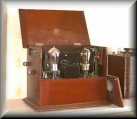Getting the scene boundaries right ( and with music)

You have to answer these following questions - creatively! What follows are recommendations - you make these techniques work for yourself.
SCENE BOUNDARIES - beginning and ending scenes - your choices
| STRAIGHT CUT | FADE INTO | FADE OUT | CROSSFADE |
| 'ARCHERS' FADE - fade out to silence (2 seconds or less) and fade in the new scene | |||
| Music bridge and music FX | FX (sound effect) bridge | ATMOS BRIDGE | MONTAGE |
| Non-realist and 'art' pieces - other techniques | |||
POSTPRODUCTION - the Product - being creative and an engineer
| 'SOFT INTO' = FADE UP GRADUALLY |
| 'HARD INTO' = STRAIGHT INTO THE SCENE |
1. How does this scene end and how does the new scene begin?
Does the new scene establish itself immediately - a 'hard' into? Or slowly - a 'soft' into?
RULE: If the new scene is a 'soft' into - then you nearly always do NOT have a silence between scenes. You have a crossfade. Try out alternatives - and you decide.

2. What is the design of the play and this sequence overall?
Am I building up the energy towards an exciting climax? Do I need to have a silence at a scene boundary?
RULE: You probably need a silence (fade to silence) after a scene.
Especially if you have brought something to a temporary conclusion. Or if something very significant and exciting has happened.
You want your audience to have a little rest before the new scene.
THINK - Would it be too much if you pushed on too swiftly? Your listeners need some little time to catch up.
It's your creative judgement and design - try out alternatives. That is what radio drama is about!

3. Do I use a music bridge? It depends on the genre of the play, and copyright for music.
Music - underscoring, signature tune (for soap or play), emotional, dramatic, music bridge
You should try out witty and ironic music bridges. They are a great way of adding that entertaining extra.
Examples from scripts on this site - (plot situation) after a date has gone wrong - 'It's raining men'.
DJ Smooth, a character in 'The Canterbury Vampires' soap - (music bridge) 'Smooth Operator' - and as a character he was very much not a smooth operator!
You might build your scripting around these music bridges.
If you use underscoring music, this could come to a climax at the end of a scene. The next scene is a 'hard' into.
CONTINUING THROUGH THIS SITE: scene boundaries - more
|
|
||
| Perspective |
|
|
|
|
|
|
|
|
|
|
|
|
This site is 'Radio Drama - directing, acting, technical, learning & teaching, researching, styles, genres'. See INDEX to navigate also. Complete curriculum of scripts, techniques (acting & directing & post-production & genre styles), advice, sound files - effects and atmoses (with no copyright and so free to use), detailed script commentaries, etc.
TECHNIQUES - FULL RANGE OF RADIO DRAMA TECHNIQUES ON THESE SITES
Academic material on this site is
Alan Beck is licensed under a Creative Commons Attribution-Non-Commercial-Share Alike 2.0 UK: England & Wales License.
Learn about radio drama on this site along with my book - Beck, Alan, Radio Acting, London: A & C Black ISBN 0-7136-4631-4 Available on Amazon. CLICK HERE.
To the WELCOME PAGE for Alan Beck's sites. See more of Alan Beck's work.
Any opinions expressed in this site are the personal opinions of the owner of the site. IF YOU HAVE COMMENTS, PLEASE EMAIL TO : [email protected]


